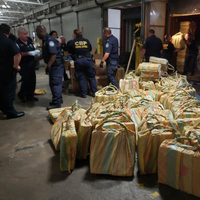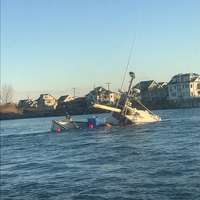17.5 Tons of Cocaine found on Containership

A U.S. Customs and Border Protection (CBP) and Immigration and Customs Enforcement Homeland Security Investigations (HSI)-led multi-agency examination of shipping containers at the Philadelphia seaport netted a historic load of cocaine, the largest cocaine seizure in the 230-year history of U.S. Customs and CBP, with an estimated weight of over 17.5 tons and a street value of about $1.1 billion.During a midstream joint boarding Sunday night, CBP, HSI, and U.S. Coast Guard authorities detected anomalies while examining seven shipping containers aboard the MSC Gayane…
Fishing Vessel Sinks in New Jersey

The U.S. Coast Guard said it is monitoring the salvage of a partially-sunken commercial fishing vessel in Manasquan Inlet, N.J.Watchstanders in the Coast Guard Sector Delaware Bay command center received notification at 2 a.m. Saturday that the 44-foot fishing vessel Miss Kathleen allided with the northern Manasquan Inlet jetty and was taking on water with three people and a dog aboard.The Miss Kathleen’s captain intentionally grounded the vessel on Dog Beach, about 20 yards outside the channel.
Chicago Electric Fish Barrier Safety Analysed
The US Coast Guard apprises that a study by its Research and Development Center concluded that the current rules governing vessel traffic across Chicago’s electric fish dispersal barrier effectively address the risks posed by the barrier’s electrified waters. The electric fish barrier system in the CSSC was built and is maintained by the U.S. Army Corps of Engineers to limit the spread of various aquatic invasive species, including Asian carp, between the Great Lakes and Mississippi River basins. Coast Guard regulations prescribe operating rules and guidance for commercial and recreational mariners transiting the Chicago Sanitary and Ship Canal. The study found that existing regulations substantially mitigate the risks associated with the barrier.





